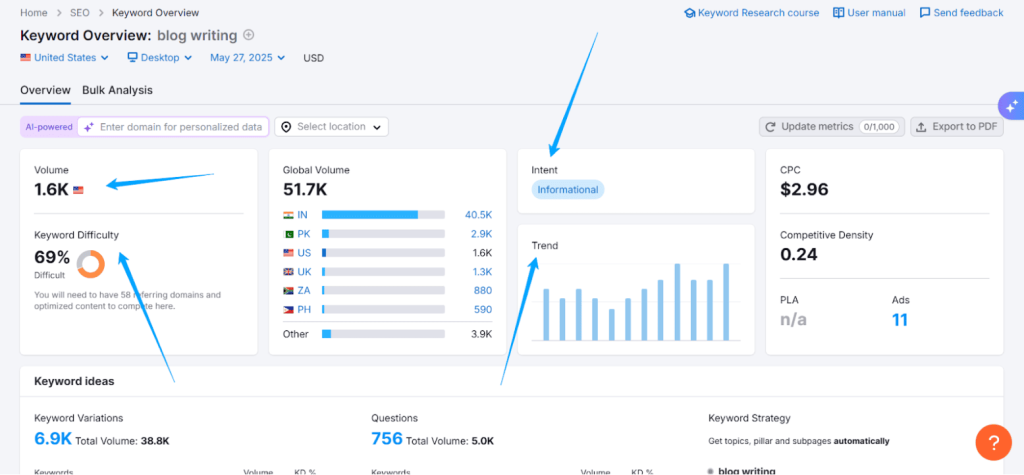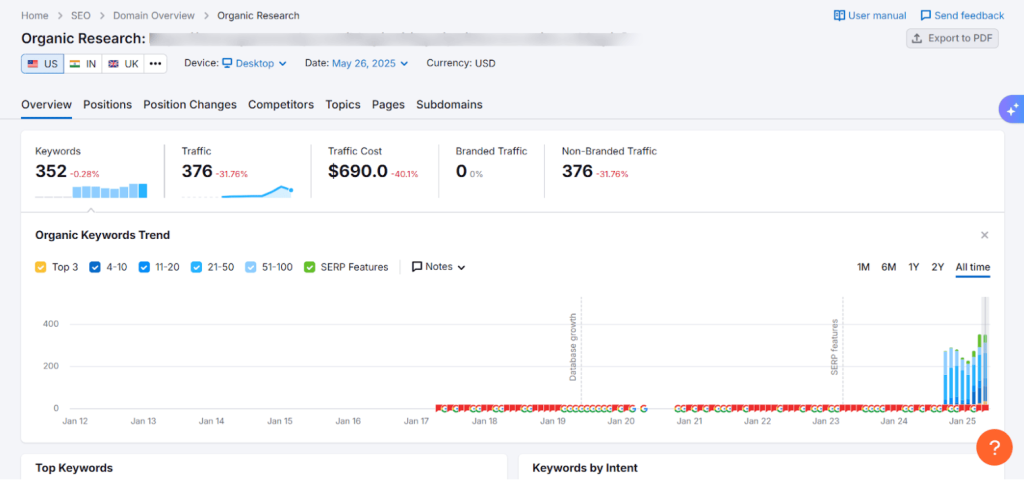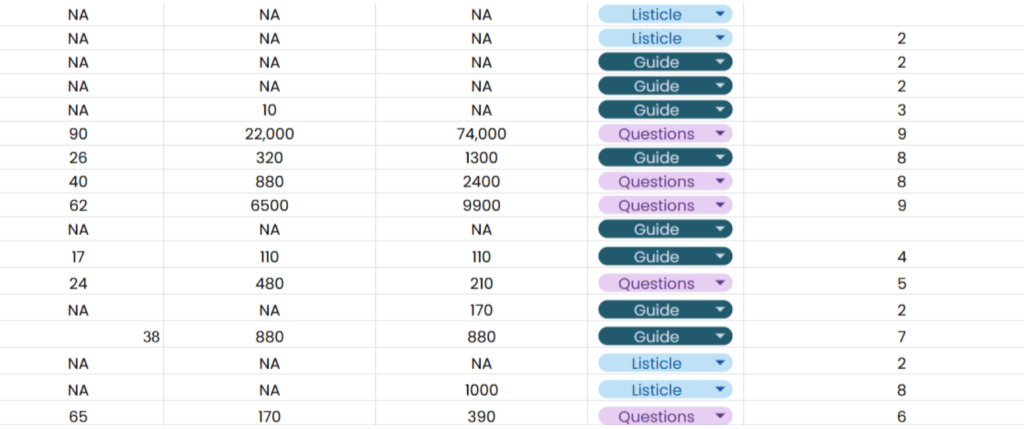Most content creators are guessing when it comes to SEO, writing posts, crossing their fingers, and hoping to rank. I’ve been there too.
But the real difference between invisible posts and top-ranking content lies in keyword research.
After building multiple websites and generating over 500,000 monthly visitors, I’ve learned that Semrush is the most complete tool for discovering high-impact keywords, and also for some low-impact ones. More on this further.
In this article, I’ll walk you through my exact keyword research workflow using Semrush, the same one I use to find low-competition, high-intent terms that drive traffic.
Why I Use Semrush?
Semrush became my go-to tool because it solves three critical problems that plagued my earlier keyword research efforts.
First, it provides unmatched competitor intelligence. I can see exactly which keywords are driving traffic to my competitors and identify gaps in their strategies.

Second, the platform provides personalized keyword difficulty scores that take into account my domain’s authority, offering realistic ranking expectations rather than generic difficulty metrics.
Third, Semrush’s integrated approach enables me to conduct keyword research, track rankings, analyze backlinks, and audit technical SEO issues all within one platform, eliminating the need to juggle multiple tools and subscriptions.
Prerequisites for Keyword Research on Semrush
Successful keyword research begins long before you open Semrush; it starts with strategic groundwork and clear objectives.
Without proper preparation, even the most sophisticated keyword tools can become ineffective, resulting in wasted time and misaligned content strategies.
From basic Semrush academy, my years of research, success, and failures, I follow these steps prior to any keyword research.
Understanding Your Goals & Niche
Before diving into Semrush, I always clarify two fundamental questions:
- Q: What specific outcomes do I want from this content
- Q: Who exactly am I trying to reach?
This isn’t about broad demographics—it’s about understanding the precise problems my audience faces and how they search for solutions.
For instance, if I’m targeting small business owners struggling with SEO, they might search for “how to improve Google rankings” rather than “search engine optimization best practices.”
I document these user personas and their likely search behaviors because they directly influence which keywords I prioritize and how I interpret Semrush data.
Brainstorming Seed Keywords
My seed keyword brainstorming process begins with three key sources: direct customer feedback, competitor analysis, and research into industry terminology.
I compile a list of 10-15 broad terms that represent my core topics, but I also include phrases my actual customers use when describing their problems.
For example, while researching content marketing keywords, I might start with obvious seeds like “content marketing” and “blog writing,” but I also include customer language like “getting more website visitors” or “creating engaging posts.”
These customer-derived seeds often lead to less competitive, high-converting keyword opportunities that other marketers overlook. I organize these seeds by search intent categories (informational, commercial, transactional) to streamline my Semrush analysis workflow.
My Semrush Keyword Research Workflow: The Core Process
Here is a systematic approach I follow that transforms random keyword hunting into a strategic, repeatable process that consistently uncovers high-value opportunities.
Step 1: Using The Keyword Overview Tool
The Keyword Overview tool serves as my research foundation, providing essential baseline data that guides every subsequent decision in my keyword strategy.
- Entering Seed Keywords: I begin every keyword research session in Semrush’s Keyword Overview tool by entering my seed keywords one at a time, though the tool accepts up to 100 keywords for bulk analysis.
For demonstration purposes and explaining the process for if you were to search for keyword ideas about blog writing. - Analyzing Key Metrics: The Keyword Overview dashboard presents five critical metrics that shape my entire keyword strategy:

- Volume: Monthly search frequency, but I focus more on volume trends than absolute numbers, a keyword with 1,000 consistent monthly searches often outperforms one with 5,000 declining searches.
- Keyword Difficulty (KD%): Shows ranking competition, but I pay closer attention to Personal Keyword Difficulty when I’ve added my domain, as this accounts for my site’s topical authority and current rankings.
- Intent: Classification reveals whether searchers want information, are comparing options, or are ready to purchase. I’ve learned that targeting the wrong intent wastes months of effort, trying to rank a product page for an informational keyword simply doesn’t work.
- Trend: Data helps me identify seasonal patterns and growing or declining search interest, which influences my content calendar timing.
- SERP Features: Show whether the keyword triggers featured snippets, video results, or shopping ads, helping me understand the competitive landscape and content format expectations.
Step 2: Using The Keyword Magic Tool
This is where keyword research transforms from basic analysis into comprehensive opportunity discovery, expanding single seed keywords into massive lists of targetable terms.
My filtering strategy focuses on uncovering realistic opportunities rather than chasing vanity metrics.

Here’s how I approach each filter type:
Match Types:
- Broad Match: Shows all variations to see the complete landscape.
- Phrase Match: Finds keywords containing my exact seed term.
- Exact Match: Provides precise variations.
- Related: Reveals synonyms and adjacent topics that expand content possibilities.
Questions Filter:
Particularly valuable because question-based keywords typically have lower competition and more precise user intent.
I can immediately identify what my audience wants to know, which directly translates into content ideas that rank well and drive engagement.
My Core Filtering Workflow:
- Volume filters: Based on my site’s authority (newer sites get 100+ monthly searches, established sites can target 1,000+).
- KD% filters: Match my domain’s competitive ability.
- Intent filters: Align with my content goals.
- CPC data: Helps identify commercial value; higher CPC often indicates stronger buyer intent.
Include/Exclude Keywords:
Help me narrow my focus or eliminate irrelevant terms. For example, when researching “coffee” keywords, I might include “brewing” to focus on preparation content while excluding “shop” to avoid local business queries.
Advanced Filters:
Let me target specific word counts (longer phrases often have lower competition), SERP features (to identify featured snippet opportunities), and competitive density levels.
Grouping Keywords:
Semrush’s keyword grouping feature automatically clusters related terms, helping me identify topic themes and content consolidation opportunities, rather than creating separate pages for every minor keyword variation.
Step 3: Understanding the Competition
Competitive analysis reveals the strategic landscape and uncovers opportunities that pure keyword research alone cannot identify.

Competitor Analysis:
Using Semrush’s Organic Research tool to analyze competitors who rank for my target keywords, focusing on their top-performing content, and identifying gaps in their keyword coverage that I can exploit.
Keyword Gap Analysis:
The Keyword Gap tool reveals the most strategic opportunities by comparing my keyword profile against up to four competitors simultaneously.
I focus on “Missing” keywords (terms all competitors rank for but I don’t) and “Weak” keywords (terms where I rank lower than competitors).
This analysis often uncovers high-value keywords I completely overlooked during initial research.
Step 4: Finding Content Ideas: Topic Research Tool
Beyond individual keywords lies the opportunity to create comprehensive, authoritative content that dominates entire topic areas.
Generating Content Ideas:
Semrush’s Topic Research (finder) tool goes beyond individual keywords to suggest comprehensive content themes and subtopics, helping me create thorough, authoritative content that comprehensively covers user questions.
The tool provides headline suggestions, related questions, and content outlines that ensure my articles align with search intent and competitive content depth, while identifying unique angles that differentiate my content.
Step 5: Validating and Prioritizing Your Keyword List
Your raw keyword lists need strategic organization and prioritization to become actionable content strategies that drive real business results.
Creating Your Master List:
I compile all promising keywords into Semrush’s Keyword Strategy Builder, which serves as my central keyword repository and planning hub.
Keyword Prioritization:
My keyword prioritization considers four factors:
- Search volume.
- Ranking difficulty relative to my site’s authority.
- Commercial value based on CPC and user intent.
- Strategic fit with my content goals.
I assign each keyword a score from 1-10 for each factor, then multiply by weighting factors (I weight strategic fit highest, followed by difficulty, then volume and commercial value).

This systematic approach prevents me from chasing high-volume keywords that don’t serve my business objectives.
Choosing Long-Tail vs. Short-Tail Keywords
I typically target 70% long-tail keywords (3+ words) and 30% short-tail keywords, as long-tail terms offer clearer intent, lower competition, and often better conversion rates despite lower individual search volumes.
With the upcoming SEO trends in 2025, users are seen to have been searching for long term queries more than short keywords.
Final Stage: Putting It All Together
As you must know, raw keyword data becomes valuable only when transformed into strategic content that ranks well and serves your audience’s needs effectively.
Mapping Keywords to Content Types
Once I’ve identified target keywords, I map them to appropriate content formats based on search intent and SERP analysis.

Informational keywords become blog posts or guides, commercial keywords become comparison articles or case studies, and transactional keywords inform product pages or service descriptions.
I also consider content depth, as some keywords require comprehensive pillar content while others work best as focused, specific articles.
On-Page SEO Basics
I naturally incorporate target keywords into titles, meta descriptions, headers, and body content, avoiding keyword stuffing.
The key is to satisfy user intent first, then optimize for search engines second. I also ensure my content thoroughly addresses related questions and subtopics that Semrush revealed during research.
Beginner Level Strategies for Semrush Keyword Research
These foundational strategies help newcomers avoid common pitfalls and maximize their keyword research effectiveness from day one.
Master these basics before advancing to more complex techniques.
1. Don’t Ignore “People Also Ask” (PAA) within Semrush Reports
These question-based keywords often represent untapped opportunities with clear user intent and manageable competition levels.
2. Setting Up Position Tracking
I immediately add target keywords to Semrush’s Position Tracking tool to monitor ranking progress and identify quick optimization wins.
3. Using Semrush Projects
The Projects feature consolidates all keyword research data with site audits and competitor monitoring for comprehensive SEO management.
4. The Power of Local SEO Filters
When targeting local markets, I use location-specific filters to identify keywords with local search intent and manageable geographic competition.
5. Iterative Process
Keyword research isn’t a one-time task that I ignore once done. I revisit and expand my keyword lists monthly, especially after publishing new content and identifying ranking opportunities.
6. Don’t Get Fixated Only on High Volume
Some of my most profitable content targets keywords with under 500 monthly searches but extremely high commercial intent and low competition. Quality trumps quantity in keyword selection.
Strategies For Intermediates and Experts for Semrush Keyword Research
These advanced strategies go beyond standard keyword research practices, leveraging lesser-known Semrush features and sophisticated analysis techniques that separate seasoned SEOs from beginners.
1. Extract Hidden Question Keywords Using API Data
The API integration feature has been game-changing for uncovering overlooked opportunities.
By systematically extracting “People Also Ask” data and cross-referencing it with keyword difficulty scores, I’ve discovered detailed, specific queries that competitors completely miss but audiences actively search for.
2. Create Advanced Position Tracking Systems
Rather than tracking keywords in one massive list, custom tagging transforms position monitoring into strategic intelligence.
Grouping keywords by funnel stage, content type, and business priority reveals performance patterns, while cannibalization reports catch pages that accidentally compete against each other.
3. Build Comprehensive SEO Intelligence Hubs
The real power emerges when combining multiple data sources within Projects.
Keyword research becomes far more strategic when viewed alongside competitor movements, backlink opportunities, and technical issues, creating insights that individual tools simply cannot provide.
4. Master Multi-Layer Filtering for Micro-Niches
Most marketers use basic filters, but layering location and industry filters simultaneously reveals incredible opportunities.
This approach consistently uncovers profitable keywords with virtually no competition in specific geographic or demographic segments that broader research misses entirely.
5. Treat Keywords as Living, Dynamic Assets
Static keyword lists become obsolete quickly in today’s search landscape.
Monthly performance reviews and strategic adjustments based on seasonal trends, algorithm changes, and emerging search patterns have transformed my keyword strategy from reactive to predictive.
6. Focus on Revenue-Generating Keywords Over Vanity Metrics
High search volume doesn’t guarantee business success. Analyzing actual click-through rates, conversion data, and customer lifetime value reveals which keywords drive qualified traffic rather than just impressive numbers a distinction that separates profitable SEO from vanity metrics.
As an expert who’s aiming to dominate the search engine in 2025, you must also be aware of the current SEM best practices that are changing the game.
More From My SEO Playbook:
Conclusion: I Follow 5 Essential Steps While Researching For Keywords on Semrush
My Semrush keyword research workflow centers on understanding user intent, analyzing competitive opportunities, and systematically prioritizing keywords based on realistic ranking potential and business value.
This data-driven approach transforms keyword research from guesswork into a predictable growth strategy.
Consistent, strategic keyword research creates compound advantages—each successful piece of content builds domain authority that makes future keywords easier to rank for. Remember that even the best keyword research is worthless without consistent action and continuous refinement.
Start implementing this workflow today and adjust based on your unique audience and competitive landscape.







